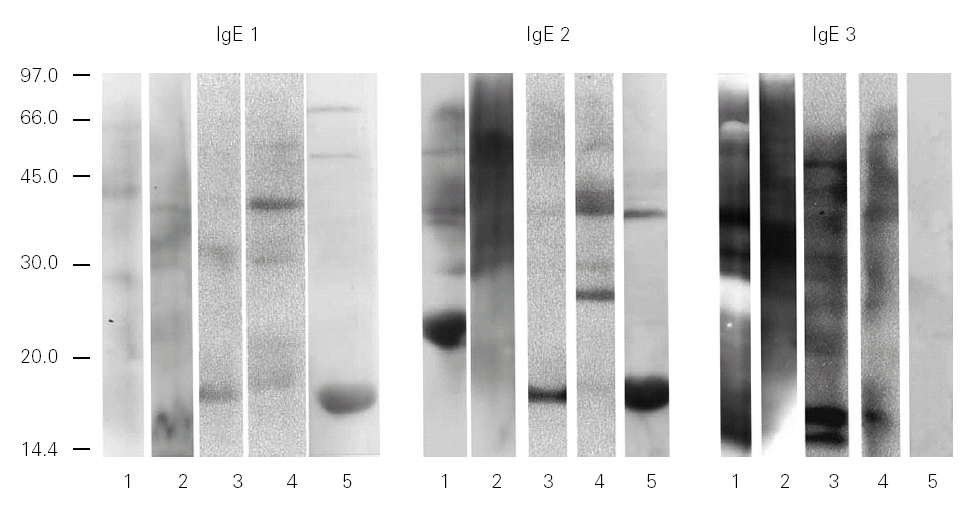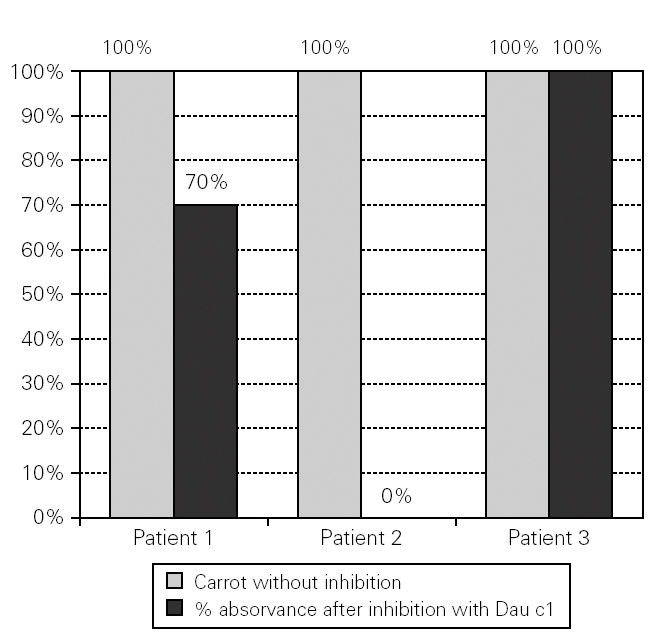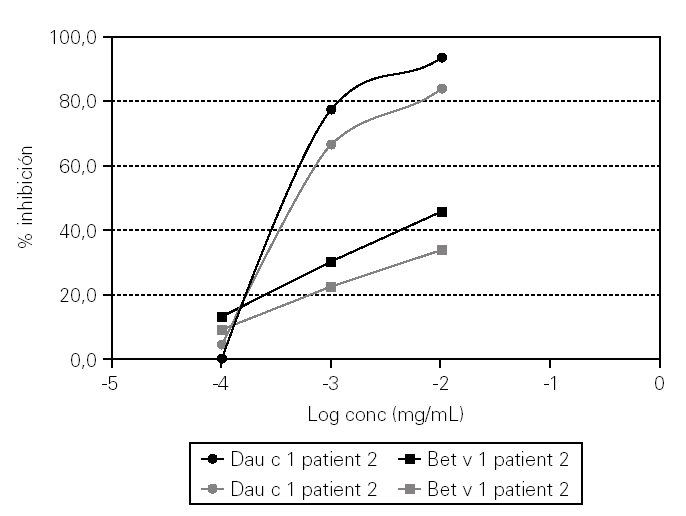INTRODUCTION
The carrot (Daucus carota L.) is a vegetable that belongs to Umbelliferae family (Apiaceae). It is an important allergenic food. Vegetables belonging to the Apiaceae family are frequent causes of pollen-related food allergy 1,2. Carrot allergy is associated with the celery-carrot-birch-mugwort-spice syndrome2. In tree pollenallergic patients, food allergy is mediated mainly by cross-reactivity of Bet v 1, the major allergen of birch pollen, and its homologous proteins in foods of plant origin belonging to the pathogenesis-related protein-10 family 3. The allergen Dau c 1 from carrot has been identified as a Bet v 1 homologous protein 3. In patients with carrot allergy without associated sensitization to birch and mugwort pollens Bet v 1 does not appear to be a relevant allergen, suggesting that additional allergens may induce sensitization 4.
Few reports of vegetable-induced respiratory symptoms have been reported 5,6. The handling of carrot has rarely been described as a cause of asthma, and few previous reports of carrot-induced asthma have been confirmed by objective tests 5. We reported a patient with carrot induced asthma, where primary sensitization due to airborne allergens of foods and the lack of pollen allergy were notorious events 7.
Now, the purpose of our work is to assess the role of Dau c 1 in three patients with three different patterns of carrot induced asthma.
CASE REPORTS
Patient 1
A 47-year-old woman, who worked as a cook, suffered from asthma, contact urticaria, rhinitis and conjunctivitis when handling raw carrots. She reported minor symptoms after handing celery or other apiaceae spices. She could eat well cooked carrot. We did not detect sensitization to pollens. She did not tell any other allergic symptoms. She did not suffer any pollinosis symptom.
Results of skin prick tests with common inhalants were negative. Skin tests were also performed, prick by prick, with fresh carrot and fresh celery. Skin prick tests were also performed with extracts of other Umbelliferae vegetables (cumin, coriander, aniseed, caraway, parsley, and fennel) which were prepared at 1:10 wt/vol in phosphate-buffered saline. Results of skin tests were positive in response to carrot, celery, aniseed and fennel. Rubbing test with fresh carrot was positive.
Total serum IgE was 152UI/mL. Specific IgE (CAP System FEIA; Pharmacia, Uppsala, Sweden) to carrot was 4.44 kU/L. Specific IgE to celery was 2.5 kU/L, to aniseed 0.47 kU/L, to fennel 0.5 kU/L, and to parsley 0.38 kU/L. Determinations of specific IgE (CAP System FEIA; Pharmacia, Uppsala, Sweden) to mugwort, grass and birch pollens were negative.
Inhalative provocation test was performed as a handling test. After 3 months without going to work, her asthmatic symptoms were controlled. Then, the use test with fresh carrots was performed. She was cutting little slices of 5 fresh carrots in a closed room for 5 minutes. She elicited a fall in FEV1 of 25 % from baseline 10 minutes after this challenge. In a different day a conjunctival challenge test was strongly positive with a carrot extract at 1:20 wt/vol in phosphate buffer saline.
Patient 2
A 41-year-old woman suffered rhinitis, conjunctivitis and cough, with allergic sensitization to grass pollen. She referred rhinitis and asthma due to the handling of raw carrots and umbellifereae spices.
Total serum IgE was 145 UI/mL. Specific IgE (CAP System FEIA; Pharmacia, Uppsala, Sweden) to carrot was 12.3 kU/L. Specific IgE to celery was 12 kU/L, fennel 2.5 kU/L, and parsley 1.6 kU/L. Specific IgE to Lolium perenne was 0.49 kU/L, to Olea europaea 0.45 kU/L, and to mugwort, and birch pollens (CAP system FEIA) was negative.
Inhalative provocation test was performed as a handling test. She was cutting little slices of 5 fresh carrots in a closed room for 5 minutes. She elicited a fall in FEV1 of 20 % from baseline 15 minutes after this challenge.
Patient 3
A 20-year-old woman was diagnosed of rhinitis, conjunctivitis and asthma due to allergic sensitization to dust mites, grass pollen, olive tree pollen, weeds pollen (Artemisia, Plantago, Rumex and Chenopodium) and cat. She suffered atopic dermatitis. She suffered from oral allergy syndrome and asthma due to raw carrot ingestion and inhalation.
Total serum IgE was 1442 kU/L. Specific IgE to carrot (CAP System FEIA; Pharmacia, Uppsala, Sweden) was 12 kU/L. Specific IgE to celery was 7.6 kU/L, fennel 13.5 kU/L, and parsley 10.5 kU/L.
Inhalative provocation test was rejected.
IMMUNE ASSAYS
Immunoblot analysis
Protein extracts of Artemisia vulgaris, Apium graveolems, Daucus carota, Betula verrucosa and recombinant form of major allergen of carrot, rDau c 1 (Biomay) were separated by sodium dodecyl sulphate-polyacrylamide gel electrophoresis (SDS-PAGE).
IgE immunoblot analysis was performed with sera of the 3 patients. The binding of IgE antibody to allergens was analyzed by Western blot using sera from the allergic patients and anti-human IgE peroxidase conjugate (Dako, Carpinteria, California, USA). Chemiluminiscence detection reagents (Cheluminiscence Reagent PLUS Western lightning. Perkin Elmer) were added following the manufacturer's instructions. Western blot revealed different IgE bindings capacities of band protein transferred from tested extracts. The allergen Dau c 1 from carrot extract and rDau c 1 were recognized by IgE antibodies from the sera of the patients 1 and 2. However, the corresponding band of Bet v 1 (homolog protein) in betula verrucosa extract was not recognized by patient's 1 and 2 sera. The serum of patient 3 did not reveal IgE binding capacity for these allergens as shown the figure 1. In patient 3, several other bands appeared.
Figure 1.--IgE-Inmunoblotting in patients 1 (IgE 1), 2 (IgE 2) and 3 (IgE 3). Lane-1: Artemisia vulgaris. Lane-2: Apium graveolems. Lane-3: Daucus carota. Lane-4: Betula verrucosa. Lane-5: rDau c 1.
ELISA and ELISA Inhibition assays
rDau c 1-specific IgE antibodies were measured by an ELISA experiment. In brief, the plates were coated with 0,25 mg/mL of the recombinant carrot allergen. Sera were diluted 1:2. The bound IgE was detected by biotinilated mouse monoclonal anti-human IgE antibody (1:1000; 50 μL/well; Operon, Spain) followed by streptavidin-HRP-labelled anti-mouse IgG antibody (1: 5000; 50 mL/well; Sigma); IgE binding was detected using a solution of TMB (50 μL/well; Sigma). The results, expressed as optical density (OD) values, were 0,309; 0,462 and 0,002 OD for the patients 1, 2 and 3 respectively.
Specific IgE ELISA-inhibition experiments were conducted in a similar manner. A first assay was performed with carrot as solid phase. There was an intermediate inhibition (30 %) between carrot and rDau c 1 in patient 1. The results indicated a considerable inhibition (nearly 100 %) between carrot and rDau c 1 in patient 2. No inhibition (0 %) was found between carrot and rDau c 1 in patient 3 (fig. 2).
Figure 2.--A first assay was performed with carrot as solid phase. There was an intermediate inhibition (30 %) between carrot and rDau c 1 in patient 1. The results indicated a considerable inhibition (nearly 100 %) between carrot and rDau c 1 in patient 2. No inhibition (0 %) was found between carrot and rDau c 1 in patient 3.
We performed other assay of specific IgE ELISA inhibition between rDau c 1 and recombinant rBet v 1, employing rDau c 1 as solid phase, only in patients 1 and 2, because the serum of patient 3 did not revealed IgE binding to these allergens. The rBet v 1 showed less than 40 % of inhibition of rDau c 1 in patient 1. There was intermediate inhibition (a bit bigger than 40 %) between rBet v 1 and rDau c 1 in patient 2 (fig. 3).
Figure 3.--IgE ELISA inhibition employing rDau c 1 as solid phase, in patients 1 and 2. rBet v 1 showed less than 40 % of inhibition of rDau c 1 in patient 1. There was intermediate inhibition (> 40 %) between rBet v 1 and rDau c 1 in patient 2.
DISCUSSION
Although carrot is frequently involved in food allergy and oral allergy syndrome, usually in association with other foods, it alone is rarely responsible for severe systemic reactions or asthma 8.
In adults, food allergy to vegetables mainly develops secondarily as a consequence of sensitization to inhalant allergens on the basis of IgE cross-reactivity. Carrot allergy is well known to be highly associated with a sensitization to birch or mugwort pollen 2. However, some individuals may have allergy to carrot without it being associated with birch pollen allergy 4.
A number of carrot allergens have been characterised: Dau c 1, a 16 kDa (or 18 kDa) 4 protein, a Bet v 1-homologue, a major allergen 3, with various Dau c 1 isoforms 3; Dau c 4, a profilin 9 and Dau c Cyclophilin, a 20 kDa protein 10. A 35 kDa protein related to Bet v 5, an isoflavone reductase-related protein, and a Bet v 6-related food allergen of approximately 30-35 kDa a phenylcoumaran benzylic ether reductase (PCBER) a plant defence protein, have been detected 11.
In the Midland of Spain, the sensitization to Betula verrucosa is uncommon. Grass pollen, Olea europaea pollen and weeds pollen are the most common allergens. Our patients were living in an area without birches.
In our work, the patient 1, with carrot induced occupational asthma, responded exclusively to carrot allergens. Pollen allergens seemed to be trivial. The initial sensitization seemed to be acquired from carrot itself. Moreover, Dau c 1 is not the principal allergen in patient 1. It is not able to inhibit more than 30 % of IgE binding to carrot. So, other allergens from carrot are probably implicated in the sensitization in this patient. Looking at the immunoblotting, there was a band with apparent molecular weight of 30 kd which could correspond to a phenylcoumaran benzylic ether reductase (PCBER) that looked like the predominant allergen. A previous report described a 34-year-old female cook who experienced allergic rhinoconjunctivitis and contact urticaria when she handled raw carrot 12. This patient, who had many similarities with our patient 1, had suffered anaphylactic episodes after accidental ingestion of raw carrots but tolerated boiled carrots. In this instance, monosensitisation to an 18-kDa protein in carrot was reported 12.
Patient 2 showed other findings. Dau c 1 seemed to be the major allergen in this case, and it was able to inhibit 100 % IgE binding to carrot. In this case, the patient was not exposed to birch pollen. Her carrot sensitization could not be explained by his pollen allergy. We think that, like patient of case 1, this woman was sensitized directly from carrot allergens.
In patient 3, Dau c 1 is not related with the carrot allergy. It did not inhibit the IgE binding to carrot. The carrot extract showe d other bands binding IgE in the immunoblotting. These bands were not completely similar to birch pollen allergens, and seemed to be related to native pollen allergens as weeds.
In our patients, rDau c 1 has not been a complete homologous of rBet v 1, as is demonstrated by the incomplete inhibition that we found between both proteins. In a recent work, a subset of patients binding to the carrot allergens was only partially inhibited by Bet v 1 or birch pollen extract 13. The explication should be in the different isoforms of Dau c 1. Isoform Dau c 1.0201 proved to be a weak inhibitor of IgE-binding to Dau c 1.0104 and vice versa in a major subgroup of carrot allergic patients 13. Some of the patients in this report had IgE to Dau c 1 without being sensitized to Bet v 113. This fact, with our findings, point towards a primary sensitizing capacity of the food allergens in cases 1 and 2. Airborne carrot allergens are able to sensitize without the implication of a previous pollen allergy.
The different kinds of airborne pollens in different European areas, could also explain the lack of implication of birch pollen allergens in development of food allergies. Mediterranean countries did not show the same patterns of food-related pollen allergy than Nordic countries. The patient of the case 3 is an accurate example of this fact.










